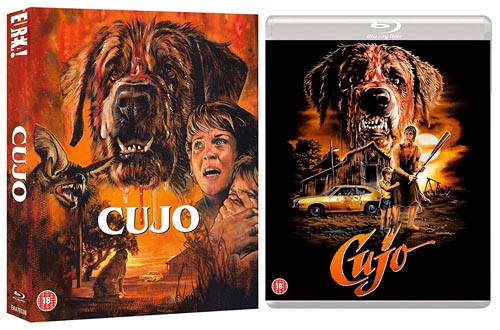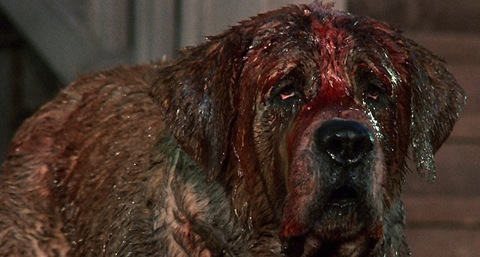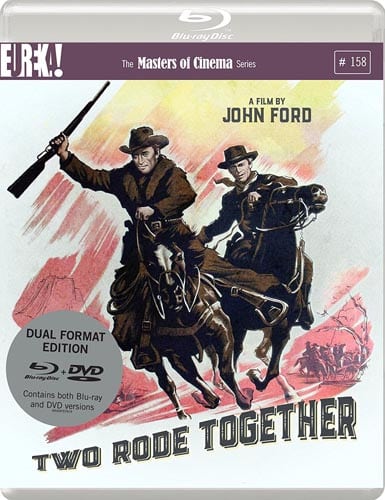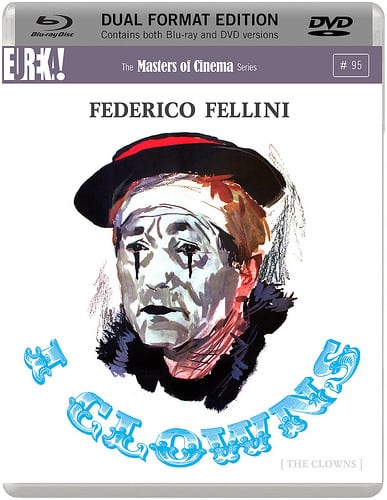Cujo (1983)
Directed by: Lewis Teague
Written by: Don Carlos Dunaway, Lauren Currier
Starring: Christopher Stone, Daniel Hugh Kelly, Danny Pintauro, Dee Wallace
USA
AVAILABLE ON BLU-RAY, SPECIAL LIMITED EDITION: NOW, from EUREKA ENTERTAINMENT
RUNNING TIME: 93 mins
REVIEWED BY: Dr Lenera, Official HCF Critic
Cujo, a friendly St. Bernard, chases a wild rabbit and inserts his head into a cave where a rabid bat bites his nose. Meanwhile Vic and Donna Trenton’s marriage is in trouble after Vic finds out that Donna’s been having an affair with her ex-boyfriend Steve Kemp. When they take their car to to the rural home of mechanic Joe Camber for some repairs, their five-year-old son Tad befriends Cujo, now the Camber family’s pet. Vic goes away on a business trip, and Donna and Tad head back to the Camber’s house for more car repairs, but once there the car breaks down – and Cujo is now not just very, very sick but very, very dangerous….
It’s been a while since we’ve heard from the proposed remake of Cujo, entitled C.U.J.O. [which stands for Canine Unit Joint Operations], but we seem to be in the midst of a Stephen King revival right now so I expect to hear news about it very soon. To us old-timers of course, it’s just like the ’80s all over again. The year 1983 saw three King adaptations, all of them different from each other: Cujo, Christine and The Dead Zone. The latter movie is generally [and rightfully] regarded as the best and Cujo as the weakest [with Christine somewhere in the middle], but after just watching Cujo for the first time in a great many years, I found it to be pretty well crafted. It manages to inject some thematic interest and even symbolism into its simple ‘mad dog’ premise – as in many horror films today, the menace can be related to tensions within the family – and, while you could call the first half slow, its second half is bed-wettingly tense, almost a masterclass in how to milk the maximum amount of tension from characters trapped in a single, very small setting. Of course in the days before CGI it was very hard to get decent animal effects in movies, but Cujo holds up better than most because it mostly [though not entirely] used real dogs along with excellent editing – and King was possibly right when he said that Dee Wallace was in his opinion the best performance by an actress in any King-based film – yes, even better than Kathy Bates.
King has admitted several times that he was so into his alcohol addiction at the time that he doesn’t remember writing it, though he did recall that his inspiration was when he met his mechanic’s intimidating dog while having his motorbike repaired. The book, the first of King’s to be set in the fictitious town of Castle Rock, had links with The Dead Zone, including hints that its serial killer Frank Dodd had posessed Cujo, but they had to be removed as the film of that book was due out two months later and from a different studio, except for the character of Sherrif Bannerman. King himself wrote the first screenplay and gave his story a happier ending, while Carlos Dunaway and Lauren Currier wrote successive drafts. Lewis Teague was the director early on, but the studio wanted a bigger name. John Carpenter turned the project down, then Peter Medak took over but was fired two days into filming, and left along with his DOP Tony Richardson. He was replaced by no less than – Lewis Teague, accompanied by Jan De Bont. The number of dogs involved is debated, but Cujo was mostly played by several St. Bernards, though with some help from a black Labrador-Great Dane mix, a puppet head, and a stuntman in a dog costume. To make the dogs attack the car, animal trainers put their favorite toys inside it so the dogs would try to get them. The foam around Cujo’s mouth was made of a concoction of egg whites and sugar, but the dogs would constantly lick the tasty stuff off, causing much delay. Shot in several rural California locations, Cujo was released to decent, if unspectacular box office, and middling reviews. There are two versions of the film, the US version and the international version. The latter loses around four minute’s worth of footage establishing the characters, but also has a few shots, like one of Donna and Steven having sex, that are not in the US version. The US version is now the only version in circulation and the only legal version available in HD.
It first feels like you’re watching a cute, kid-aimed animal flick as we see a rabbit scurrying about out set to music straight out of the ‘highly descriptive’ Disney school, but moviedom’s other famous St. Bernard Beethoven was never shown to be quite so intent on another animal as Cujo really wants that darn rabbit – and is paid for his efforts by being bitten when he sticks his nose into a cave of bats. Now we meet little Tad, going to the toilet before going back to his bedroom and being terrified by cupboard door refusing to shut properly. Quite a bit of time is spent on this ‘monster in the closet’ stuff, perhaps too much time because in terms of narrative it’s unimportant, but it does feed into the second half when Tad, after being told by his dad that “there are no such things as monsters”, has to confront one [I’d have liked to have seen a scene at the end when son confronts father with the words “I thought you said that real monsters didn’t exist” and father has some explaining to do]. There’s some foreshadowing elsewhere, such as Scooby Doo playing on TV, though not as much in the original Pet Sematary. I reckon that the version of the film I had on video for years recorded off TV was the shorter cut, because I didn’t recall there being as much stuff about Vic’s job as an advertising executive. His latest product has been accused of causing internal hemorrhaging in thousands and its catchphrase needs replacing since it’s been appropriated by others, plus a new contract has been lost. Again, you could say that this is padding, but it levels the playing field with both husband and wife being in considerable stress rather than it just being Donna. Donna’s playing away, but one night it really gets through to her how good Vic is, so the next day she goes to end it in a good example of economical yet effective staging. It’s all done in a single shot, Donna being far away from the camera on the right hand side of the screen while Steve is in bed in the foreground on the left, enhancing how weak and shameful Donna feels.
We get a snapshot of another marriage parallel to this one, one where abusive garage owner Joe lords it over his wife Charity and son Brett so much that, when she wins the lottery, she immediately gives the check to him as long as she can have a week’s break away with her sister. I reckon that the remake, if it ever gets off the ground, will omit much of this stuff in favour of more Cujo, but it’s worth pointing out that King often did far more of this in his novels, taking up many pages with the lives of his characters to give a sense of realism, and so that the intrusion of horror would have more effect. Cujo is still seen fairly often, firstly as a nice doggie befriending Tad though Donna immediately senses something wrong with him, then in an atmospheric moment set amidst thick fog almost menacing Brett, then finally claiming his first victim. Though there was no mistreatment of the dogs on set, but it’s amazing how revolting they make Cujo look, with more and more blood and generally yucky stuff appearing on him in a film that otherwise is quite low on the gore [why still the ’18’ certificate?], with the attack scenes cutting away. As the hugely extended climax comes, Cujo’s determination to break into the car in which Donna and Tad are trapped is scary, yet this animal is also probably in great pain, something that adds a touch of sympathy as with many of the great screen monsters. The intensity of some of these scenes is quite something, especially when Tad has a seizure where actor Danny Pintauro actually bit Dee Wallace’s finger for real and quite hurt her. Pintauro is fine, avoiding the usual cute kid actor mannerisms, but it’s Wallace who’s really worth studying here, because she acts being terrified in a totally note-perfect fashion so that you really believe her fear. The right amount of claustrophobia is caused throughout this section yet cinematographer Jan de Bont prevents things from getting repetitious with his varied camerawork. Maybe we didn’t need the camera circling around Donna and Tad and getting ever faster, but in, say, a Brian De Palma film it wouldn’t have seemed out of place at all.
The dog attack scenes tend to go for the ‘shakycam’ effect, but this film was made back when that irritating cinematic device was employed more out of necessity than choice to help cover up the joins in the effects. As it is, unless you slow down the film you probably won’t be able to tell where they’ve substituted one different kind of dog for another and where the man in a suit is employed, though I did notice a wagging tail in one shot which surely wasn’t intended to be seen [though it’s proof that the dogs were having fun on set]. But overall, technically Cujo is about as well done as a 1983 film without a huge budget could be. Meanwhile you can see Cujo as a manifestation of the rift in the Trenton marriage, but even more so as Donna’s guilt made literal. I don’t think that it’s for nothing that one of the attack scenes is made to look rather sexual, Donna looking rather like she’s in the throes of some sexual passion while the dog goes for rather ‘low down’ parts of the body. The theme of sin is probably weaker in the film than the book which had a much more downbeat conclusion and therefore seemed to say that sin is never really forgiven or forgotten. But there’s enough of this idea in the film to help give it a bit of metaphorical weight even though it tells an essentially simple story. Lewis Teague, who for some reason virtually disappeared into TV movie hell after hitting the big time with The Jewel Of The Nile [though his best work remains the terrific creature feature Alligator], and his team have paid some attention to details. It can’t be accidental that, at the end, both a cereal packet and a carton of milk are seen right beside Donna. Both seem to refer to the troubles of both Vic and Donna earlier on in the movie, and maybe hint that things may turn out okay without overdoing it.
Teague occasionally stumbles, such as with a jump scare near the end – though that may have been more down to editor Neil Travis who doesn’t quite get it right here – and you do get the odd dumb moment like Donna smashing the back window of the car to get to her son who’s on the back seat yet has no glass whatsoever fall on him. Some modern viewers might find Charles Bernstein’s music score to be too prevalent, though the composer, who did several notable horror films of the period like The Entity and A Nightmare On Elm Street, obviously relished the opportunity to create a denser work than normal with some differing moods. Overall though Cujo, while never going to be considered anywhere near the top of King film adaptations, holds up rather well. It is very predictable, but is still done well in most respects and does quite a lot with perhaps not very much – and it’s even kind of plausible, being totally absent of the usual supernatural elements. We’re all frightened by different things and personally I find the idea of a rabid animal, especially if it’s man’s best friend, to be very frightening indeed – even if that may not be what the film is really about.
Eureka have probably used the same oldish print as the one from the Region ‘A’ Olive Films Blu-ray but given it a new encode that makes it look newer than it is. The picture is a tad soft in places, but it seems like some of this may have been intended by the cinematography. There’s a bit of black crush here and there too, but not so much that it’s distracting. There’s plenty of texture and detail, meaning that Cujo has probably never look quite as revolting as he does here, while colours look natural and grain is mostly well managed. Maybe not spectacular but still impressive in general – and Eureka have more than made up for any minor flaws with the look of the film by a great assortment of special features, all but one produced by Eureka themselves, that will make any fan of the film feel like they’re in heaven.
In place of the audio commentary with Teague that’s on the Olive, we have one by the writer of an entire book about Cujo[ as well as The Howling], Lee Gambin, and please don’t be put off by the bizarre commentary that he did on Return Of The Vampire where he spent nearly the entire time quoting from his own writings about movie werewolves. You can virtually feel his enthusiasm, though even lovers of the film may not quite agree with him that Cujo is a “fabulously perfect picture”. He gushes with praise throughout, be it for King’s writing, the acting, the staging – everything – and doesn’t criticise a single thing, though his going heavily into themes and subtext did make me happy, showing that even an average writer like me was able to pick up on some of it and wasn’t barking [sorry] up the wrong tree. His comments about class are especially interesting. You also get some good stories, details about cut scenes [you originally saw one partly seen death in full], and where different techniques were used during the dog sequences. This track is a little exhausting, but packs in an incredible amount.
We have a total of eight interviews where the participants are asked questions mostly concerning the film, some of them quite penetrating and probably from Gambin. Dee Wallace says how she took the role because it was “a tour de force part for a woman”, that it was her idea to change the ending, and describes how Peter Medak wanted her to wear a see-though blouse with no bra, one of the things that got him fired. She’s really proud of the film and her work in it which she says is her best performance. Composer interviews tend not to be very long but Charles Bernstein gets over half an hour to discuss his score and its construction, as well as to describe how composers usually have to guess the sound effects that may be in a scene and adjust their music accordingly, before playing the three main themes on the keyboard. Fascinating for film music lovers like myself. The two main stunt people are next, and both Gary Morgan [who played Cujo] and Jean Coulter are asked mostly the same questions. Morgan is very animated as he describes working with the dogs, mentions an animatronic one that never appeared in the film as it didn’t work, and says how, far from being sweltering in the suit, he was the only one who was comfortable because it was really cold. Coulter is considerably more laid back but goes into greater details about the dogs [how many there were still can’t be settled on].
This is followed by casting director Marcia Ross who among discussing how the casting was done also gives us an insight into her job while also telling us that Medak falling behind schedule was the main reason for his replacement. Visual effects artist Kathie Lawrence and special effects designer Robert Clark follow, answering mostly the same questions. Lawrence mentions how somebody else wanted to take all the credit, but later backtracks and praises him, while Clark is the only person out of the interviewees who doesn’t seem to have seen the film as the bit where each person is asked what their reactions to it were is not present! You do learn a lot about how things were made and carried out, plus more stuff about the dogs, which you you get even more of in the interview with , dog trainer Teresa Miller, daughter of Karl Lewis Miller who worked on Cujo. She has some vivid recollections including having the dogs living in her house for a while.
There a great deal of interest in these interviews and Eureka obviously tried to get as many as they could. Saying that, their lengthy combined running time and the fact that you do hear the same stuff concerning the dogs over and over again means that I’d advise you watch them in two or more lots – though if you listen carefully there are some contradictions. They do virtually make Dog Days: The Making of Cujo, ported over from the DVD, a bit redundant, but kudos for including it anyway, and it’ll serve as a more potted look at the making of the film if you want one. On fact I’d almost suggest that you watch it first, and then go for the interviews if you fancy some more detail. You do get to hear from and see some important people like Teague, Pintauro and De Bont, and it’s well paced and put together in Laurent Bouzereau’s usual top class fashion.
Eureka were kind enough to also send me the second disc that is only included in this Special Limited [to 4000] Edition. While I can’t of course comment on the booklet, I can add a few words on the two extra features on the Blu-ray. Gambin, whose involvement in this release seems to be considerable, returns for a 2015 Dee Wallace Q&A, asking his usual well thought through questions which Wallace seems to love answering judging by her high spirits and the length and detail of her responses. There’s so much of interest here, from the way she was picked for The Stepford Wives [the director Bryan Forbes walked over to her and said: “Are you an actress? Do you want to be in a movie?”] to her describing how she never rehearses and acts ‘in the moment’, to lots of anecdotes concerning her popular genre roles. Listen out for how she got through The Frighteners despite having just lost her husband, her grandmother’s reaction to a showing of The Howling, and a tale concerning the climax of Cujo not heard on any of the other special features. It’s a wonderful addition to the release, even though the movie clips have been cut out, perhaps for legal reasons. And finally we have good old Kim Newman discuss Cujo and its place amidst the wave of King adaptations. He mentions how this period was a rare example of both literary and screen horror being on the same page, and I’d agree with him that many of these films seem better when revisited many years later, seeing as I recently both Pet Sematary and Cujo to have improved with age.
I’ve come to the conclusion that Cujo is rather underrated. Maybe Gambin is on to something after all. A solid monster animal movie with some subtext if you like that sort of thing, in a superbly put together and informative package from Eureka. Recommended.
SPECIAL LIMITED EDITION [4000 UNITS] CONTAINS
*Hardbound Slipcase, featuring newly commissioned artwork by iconic British illustrator Graham Humphreys
*Reversible sleeve featuring artwork by Justin Osbourn and original poster artwork
*A LIMITED EDITION 60-PAGE Collector’s booklet featuring new writing on the film by Lee Gambin, author Scott Harrison, and Craig Ian Mann; illustrated with archival imagery from the film’s production.
SPECIAL FEATURES
*1080p presentation of the film, on Blu-ray for the first time ever in the UK
*Uncompressed LPCM mono soundtrack
*Optional English SDH subtitles
*New and exclusive feature length audio commentary by Lee Gambin, author of Nope, Nothing Wrong Here: The Making of Cujo
*New interview with Dee Wallace [40 mins]
*New interview with composer Charles Bernstein [35 mins]
*New interview with stuntman Gary Morgan [25 mins]
*New interview with stuntwoman Jean Coulter [21 mins]
*New interview with casting director Marcia Ross. [20 mins]
*New interview with visual effects artist Kathie Lawrence [13 mins]
*New interview with special effects designer Robert Clark [12 mins]
*New interview with dog trainer Teresa Miller [28 mins]
*Dog Days: The Making of Cujo archival documentary on the film s production [42 mins]
*DISC TWO [Limited Edition Only] – Q&A with Dee Wallace from Cinemaniacs & Monster Fest 2015 , moderated by Lee Gambin [96 mins]
*DISC TWO [Limited Edition Only] – New interview with critic and author Kim Newman [25 mins]











Be the first to comment